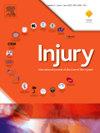Evaluating the structural, financial, and legal aspects of hospital-based violence intervention programs implementation on psychosocial outcomes and violence reduction: A systematic review
IF 2.2
3区 医学
Q3 CRITICAL CARE MEDICINE
Injury-International Journal of the Care of the Injured
Pub Date : 2025-01-23
DOI:10.1016/j.injury.2025.112181
引用次数: 0
Abstract
Background
This systematic review aims to assess different effective hospital-based violence intervention programs (HVIP) design strategies and their effects on reducing the incidence of violence-related injuries, impact on healthcare outcomes including behavioral and psychosocial outcomes, and effects on healthcare system costs.
Methods
A comprehensive search of five databases included studies that assessed the effects of HVIPs in adolescent and adult populations. The outcomes of interest included different effective HVIP design strategies that most effectively decreased the incidence of violence-related injuries, as well as their effects on behavior and psychosocial outcomes, effects on hospital costs, and whether they adequately addressed medico-legal aspects.
Results
Following the application of inclusion and exclusion criteria, 25 studies were included in the final analysis. Effective HVIP design strategies primarily focused on mentorship and hands-on learning, contributing to successful program implementation. Overall, HVIPs significantly reduced the incidence of violence-related injuries and recidivism rates among participants. Improvements in psychosocial outcomes were observed, with increased employment rates and educational engagement reported among HVIP participants. Additionally, the included studies demonstrated that implementing HVIPs led to cost-effectiveness as well as cost savings from reduced injury recidivism. Despite the acknowledgment of medico-legal resources' importance, the absence of formal partnerships hinders HVIPs from fully addressing legal barriers to recovery, such as housing insecurity, employment discrimination, and protection from violence.
Conclusion
HVIPs are effective in reducing violence-related injuries, enhancing psychosocial outcomes, and offering cost savings, however, they often lack established medico-legal resources. Further research on establishing effective medico-legal partnerships within these programs is needed.
求助全文
约1分钟内获得全文
求助全文
来源期刊
CiteScore
4.00
自引率
8.00%
发文量
699
审稿时长
96 days
期刊介绍:
Injury was founded in 1969 and is an international journal dealing with all aspects of trauma care and accident surgery. Our primary aim is to facilitate the exchange of ideas, techniques and information among all members of the trauma team.

 求助内容:
求助内容: 应助结果提醒方式:
应助结果提醒方式:


